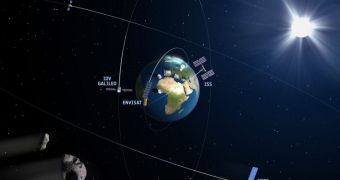Officials at the European Space Agency (ESA) say that the organization's capabilities were put to the test on Friday night EDT/early Saturday GMT, when the NASA Upper Atmosphere Research Satellite (UARS) reentered Earth's atmosphere while spiraling out of control.
The event incited a certain amount of panic among the general population, especially in the United States, where news of the impending crash was widely reported on. NASA dedicated all of its tracking capabilities to monitoring the falling spacecraft.
Yet, despite governmental agencies' best efforts, the location where UARS crash-landed is not yet known. Not even the United States Air Force's (USAF) advanced orbital debris tracking capabilities were able to figure out where the 6.5-ton satellite will impact Earth's surface.
ESA reports that the massive vehicle broke up in Earth's upper atmosphere on September 24, between 05:23 and 07:09 CEST. The event was monitored by the Space Debris Office (SDO), which kept close contact with the American space agency at all times.
“Atmospheric drag reduced the satellite's speed from 27 000 km/hr [16,777 miles per hour] such that the remaining fragments might have reached the surface at just 200 km/hr [124.2 miles per hour],” explains the head of the ESA SDO, professor Heiner Klinkrad.
In order to turn a potential catastrophe into a favorable event as well, experts around the world organized an international tracking exercise, through the Inter-Agency Debris Coordination Committee (IADC) technical body.
The IADC include, among others, ESA, NASA, European national agencies and the Russian, Chinese, Canadian, Japanese, Ukrainian and Indian space agencies. The organization has a dedicated data communication network at its disposal.
The asset supports “hazardous reentry risk assessment, which allows the exchange of tracking data and the refinement of reentry predictions in the event of an expected reentry,” an ESA press release says.
“Last week's reentry did not meet IADC's scientific criterion as a 'risk object'. However, the network is exercised annually, and, upon NASA's initiative, the UARS reentry was selected by IADC as a target for the 2011 exercise,” Klinkrad explains.
“A longer warning time and more accurate predictions will assist civil authorities to react in the most appropriate manner, protecting people and property on Earth,” the official concludes.

 14 DAY TRIAL //
14 DAY TRIAL //